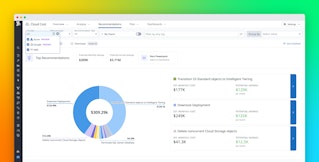
David Lentz
As you analyze your organization’s cloud spending, you’ll often find that stakeholders have different perceptions of what that spending brings you. This is especially true when overall costs are rising and it’s hard to distinguish waste from valuable investments in growth. But when finance, engineering, and product teams can all connect cloud spending to specific business outcomes, you gain the ability to make data-driven decisions about how to maximize the value of that spending.
Unit economics connects each dollar you spend to the value it brings to your business. By connecting cloud spending to customer activity such as signups, checkouts, and requests, unit economics shows you how efficiently your organization uses cloud resources, from core infrastructure to related software and SaaS subscriptions.
In this post, we’ll explain how to identify useful unit economic metrics and how to apply them to:
But first, we’ll take a closer look at what cloud unit economics is and how it can help you.
What is unit economics?
Effective cloud spending enables your organization to attain specific objectives that bring you value, such as creating a user account or completing an ecommerce checkout. You can understand the value you get for your cloud spending by analyzing costs through the lens of unit economics. Unlike measuring your overall cloud spending, measuring unit costs—how much you spend to attain a discrete business outcome—can help you understand the actual cost of delivering on your core objectives. Unit costs illustrate the value you get from the cloud.
Understanding your unit costs is critical in effectively optimizing your spending. Your optimization efforts should aim not just to decrease your cloud spending, but instead to increase the value of what you get. To do this, you need to minimize your unit costs by making strategic changes in how you use your cloud services. Driving down unit costs increases the value you get from each dollar you spend in the cloud.
For example, if your revenue comes from memberships, your unit cost might be dollars per member—the sum of the cloud costs associated with creating and maintaining each membership. A lower unit cost brings you more members—and more revenue—per dollar of cloud spending. You can decrease your unit cost by moving stale member data to cheaper storage, shifting batch processing jobs to spot compute instances, or taking advantage of rate optimizations.
In addition to informing your cost-optimization efforts, tracking unit costs can provide important context that gives you a more complete understanding of your cloud spending. For example, if your overall cloud costs increase, unit costs can show you whether it’s due to a higher cost per membership or simply due to more members.
If you’re able to decrease your unit costs even while your overall spending rises, you know that you’re gaining cost efficiency and generating more value for each dollar you spend in the cloud. In this case, the rise in cloud costs is caused by greater volume, and that additional spending is a way of accelerating your organization’s growth and capturing more revenue. Rising cloud costs might look bad, but by tracking unit costs, you can expose the value of that spending.
In the next section, we’ll look at how to identify unit metrics that are meaningful for your organization. Later in this post, we’ll show you how you can apply unit economics to improve visibility and collaboration, guide cost optimization efforts, and maximize revenue.
Define unit metrics that capture value
Unit economics helps you measure the cost of a specific outcome, but it doesn’t provide any standard metrics. This means that you need to decide what’s useful for your organization to measure. First, you need to recognize the business outcomes that bring you value. For example, a team that operates an internal developer portal attains value each time a product team deploys a change, but a non-profit organization gains value from each donation.
After you’ve identified your organization’s valuable activities (your unit metrics), you need to calculate the cloud spending that corresponds with each one (your unit costs). For example, to calculate the unit cost of a donation, you might include the cloud costs of the CDN that hosts the form, the serverless functions that process the submission, the data storage associated with creating the donor record, and the payment processing fees.
The following screenshot shows a service’s daily AWS costs per checkout. The stacked bar chart uses different colors to show the cost attributable to each of the AWS products that power the service, such as Amazon EC2, Amazon S3, and Amazon EKS.

Which cloud costs you factor into your unit costs should be defined by your FinOps team along with your internal users—the engineering teams whose work produces these metrics. Engineering teams can draw on their knowledge of the meaning and context of their services’ metrics to guide their cost-optimization efforts.
As your capability for unit economics matures, you might aim to understand your unit costs at an even more granular level. To do this, you can expand your definition of cost to include spending from across various FinOps scopes. Including related costs—such as the CRM software and email services you use to communicate with donors—can give you more accurate unit costs, but comes with additional complexity.
You can even calculate unit costs that differentiate between various levels of service to understand the amount of revenue generated by each of your activities. For example, if you offer multiple tiers of service, you should try to identify your per-user cost in each tier. This can inform your product pricing decisions and help you maximize your revenue.
Putting unit economics into practice
In this section, we’ll look at some practical examples of applied unit economics. We’ll show you how you can use unit economics to foster shared understanding of your cloud costs, create KPIs, more accurately forecast your cloud costs, and determine optimal pricing of your organization’s offerings.
Use a common language to gain a shared understanding
Without unit economics, finance, engineering, and product tend to focus on cloud costs from different angles and using different terminology. Finance teams might talk about costs in terms of variance against budget. Engineering teams might talk about technical drivers of cost, such as CPU utilization. Product teams might discuss the bottom-line cost of adding a new feature. When these stakeholders communicate about costs, these different languages can lead to inefficiency and misunderstandings.
But all of these stakeholders are committed to the outcomes that are valuable to your business. When you adopt unit economics, they can communicate and collaborate more effectively by focusing on metrics that matter to everyone. With this shared understanding, stakeholders can work together to analyze business performance and make data-driven decisions that ensure the effectiveness of your cloud investments.
Define KPIs to guide optimization and enable cost ownership
Selecting the right unit metrics and defining their costs helps you understand your cloud spending as a function of your business activity and an opportunity for growth. To guide you in maximizing that growth, you can create KPIs that give engineering teams the necessary visibility to own and continually optimize costs.

To create an effective KPI, use your unit cost’s recent history as a baseline, then set a cost-optimization target. For example, the team that owns a service might determine that they can optimize its use of cloud services to lower the unit cost by 20% without compromising its performance. This KPI is critical because it enables the team to measure the value of their work. Even if the service’s total cost increases due to higher traffic, a decreasing unit cost demonstrates that the team is operating an efficient service and that the increased spending is generating value, not waste. They can track the status of the KPI by using monitors and dashboards to stay informed about their progress and find out quickly about any regressions.
Forecast cloud costs more accurately
Your total spending is a function of your unit cost and the number of units you produce, whether that’s responding to an API request, processing a query, or storing a byte of data. By shifting your focus from your overall cloud spending to your cost per unit of value, unit economics enables you to project future costs based on your expectations of growth. Unit economics allows you to create more accurate forecasts by projecting costs based on expected business volume, while also factoring in planned efficiency improvements.

Strategic decisions that are informed by unit costs—rather than bluntly derived from aggregated cloud cost data—can help your organization identify and lean in to opportunities to maximize revenue. Unit costs show you the margins of each of your offerings so you can plan to grow your strongest products to realize the greatest gains. At the same time, this information guides you to hold back on those offerings with small or negative margins until you can cost-optimize them enough to generate meaningful value.
Determine product pricing with unit economics
Effectively pricing a digital product balances capturing the greatest gains with staying competitive in the market. Your unit cost sets a minimum price for your offerings, which enables you to use a data-driven pricing strategy to ensure that you’re not losing money on each transaction, signup, or other activity that is meant to generate value. It can also show you whether you can effectively contend with competitors offering similar services.
If your pricing strategy includes multiple tiers of service, your unit costs can give you an empirical understanding of your per-tier revenue. Your unit costs will show if your premium tier is actually your most profitable, or if you need to optimize its costs to build a bigger margin. If you’re also operating a free tier, you’re foregoing gains on each customer in order to demonstrate the value of your product. You can multiply your unit cost by your free-tier offering—e.g., 100 queries per day—to understand how much it costs you to serve those users and then closely track the impact of that investment.
Measure and maximize the business value of your cloud spending
By gaining visibility into your unit costs, you can better understand your current and future cloud spending and make data-driven decisions to guide your cost optimization and product pricing. Unit economics fosters collaboration among stakeholders and provides an organization-wide shared understanding of the value you get from each dollar you spend in the cloud. Most importantly, it gives you the confidence to invest in growth by proving that rising overall costs are not necessarily a sign of waste. Instead, they can be a direct reflection of increasing business value.
If you’re interested in learning more, see our blog posts about Datadog’s FinOps practice and how we’ve made some major cost optimizations. If you haven’t yet started using Datadog, you can sign up for a 14-day free trial.





